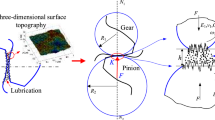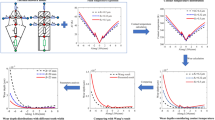Abstract
Thermoelastohydrodynamic lubrication (TEHL) analysis for spur gears with consideration of surface roughness is presented. The model is based on Johnson’s load sharing concept where a portion of load is carried by fluid film and the rest by asperities. The solution algorithm consists of two parts. In the first part, the scaling factors and film thickness with consideration of thermal effect are determined. Then, simplified energy equation is solved to predict the surfaces and film temperature. Once the film temperature is known, the viscosity of the lubricant and therefore friction coefficient are calculated. The predicted results for the friction coefficient based on this algorithm are in agreement with published experimental data as well as those of EHL simulations for rough line contact. First point of contact is the point where the asperities carry a large portion of load and the lubricant has the highest temperature and the lowest thickness. Also, according to experimental investigations, the largest amount of wear in spur gears happens in the first point of contact. Effect of speed on film temperature and friction coefficient has been studied. As speed increases, more heat is generated and therefore film temperature will rise. Film temperature rise will result in reduction of lubricant viscosity and consequently decrease in friction coefficient. Surface roughness effect on friction coefficient is also studied. An increase in surface roughness will increase the asperities interaction and therefore friction coefficient will rise.

















Similar content being viewed by others
Abbreviations
- b :
-
Half-width of contact (m)
- B :
-
Roller’s width (m)
- C pi :
-
Specific heat of roller i (J/kg/K)
- d wp :
-
Pitch radius of pinion (m)
- d wg :
-
Pitch radius of gear (m)
- E i :
-
Modulus of elasticity of roller i (N/m2)
- E′:
-
\( \frac{2}{{\frac{{1 - \nu_{1}^{2} }}{{E_{1} }}\, +\, \frac{{1 - \nu_{2}^{2} }}{{E_{2} }}}} \)
- F T :
-
Applied force (N)
- F C :
-
Load carried by asperities (N)
- F H :
-
Load carried by fluid film (N)
- F fC :
-
Asperity friction force (N)
- F fH :
-
Hydrodynamic friction force (N)
- f c :
-
Friction coefficient between asperities
- G :
-
Material number (αE′)
- h c :
-
Central film thickness (m)
- H C :
-
Non-dimensional film thickness
- K f :
-
Thermal conductivity of fluid (W/m/K)
- K i :
-
Thermal conductivity of roller i (W/m/K)
- L :
-
Thermal loading parameter
- m i :
-
ith moment of the surface
- n :
-
Asperity density
- P c :
-
Pressure carried by asperities
- R p :
-
Radius of curvature for pinion (m)
- R g :
-
Radius of curvature for gear (m)
- R :
-
Equivalent radius (m)
- sr :
-
Slide-to-roll ratio
- T 0 :
-
Oil inlet temperature (K)
- T :
-
Temperature (K)
- U :
-
Non-dimensional speed \( \eta_{0} \left( {V_{1} + V_{2} } \right)/E^{\prime}R \)
- V i :
-
Rolling velocity of roller i (m/s)
- w(x):
-
Elastic deformation
- W :
-
Non-dimensional load \( F_{T} /BRE^{\prime} \)
- Z :
-
Viscosity-pressure index
- α :
-
Pinion pressure angle
- β :
-
Radius of tip of asperities (m)
- γ 1 :
-
Scaling factor for hydrodynamic part
- γ 2 :
-
Scaling factor for asperity part
- ν i :
-
Poisson ratio for roller i
- σ :
-
Standard deviation of asperities (m)
- μ 0 :
-
Viscosity at ambient condition (Pa·s)
- μ :
-
Viscosity (Pa·s)
References
Sadeghi, F., Sui, P.C.: Thermal elastohydrodynamic lubrication of rolling/sliding contacts. ASME J. Tribol. 112, 189–195 (1990). doi:10.1115/1.2920241
Sadeghi, F., Sui, P.C.: Thermal elastohydrodynamic lubrication of rough surfaces. ASME J. Tribol. 112, 341–346 (1990). doi:10.1115/1.2920262
Hua, D.Y., Khonsari, M.M.: Thermal elastohydrodynamic analysis using a generalized non-Newtonian formulation with application to Bair-Winer constitutive equation. ASME J. Tribol. 116, 37–46 (1994). doi:10.1115/1.2927044
Hua, D.Y., Khonsari, M.M.: Application of transient elastohydrodynamic lubrication analysis for gear transmissions. Tribol. Trans. 38, 905–913 (1995). doi:10.1080/10402009508983487
Larsson, R.: Transient non-Newtonian elastohydrodynamic lubrication analysis of an involute spur gears. Wear 207, 67–73 (1997). doi:10.1016/S0043-1648(96)07484-4
Hsu, C.H., Lee, R.T.: An efficient algorithm for thermal elastohydrodynamic lubrication under rolling/sliding line contacts. ASME J. Tribol. 116, 762–769 (1994). doi:10.1115/1.2927330
Johnson, K.L., Greenwood, J.A., Poon, S.Y.: A simple theory of asperity contact in elastohydrodynamic lubrication. Wear 19, 91–108 (1972). doi:10.1016/0043-1648(72)90445-0
Gelinck, E.R.M., Schipper, D.J.: Calculation of Stribeck curves for line contacts. Tribol. Int. 33, 175–181 (2000). doi:10.1016/S0301-679X(00)00024-4
Lu, X., Khonsari, M.M., Gelinck, E.R.M.: The Stribeck curve: experimental results and theoretical predictions. ASME J. Tribol. 128, 798–794 (2000)
Akbarzadeh, S., Khonsari, M.M.: Performance of spur gears considering surface roughness and shear thinning lubricant. ASME J. Tribol. 130(2), 021503 (2008). doi:10.1115/1.2805431
Moes, H.: Optimum similarity analysis with applications to elastohydrodynamic lubrication. Wear 159, 57–66 (1992). doi:10.1016/0043-1648(92)90286-H
Gelinck, E.R.M., Schipper, D.J.: Deformation of rough line contacts. ASME J. Tribol. 121, 449–454 (1999). doi:10.1115/1.2834088
Greenwood, J.A., Tripp, J.H.: The contact of two nominally flat rough surfaces. Proc. Inst. Mech. Eng. [H] 185, 625–633 (1971)
Timoshenko, S.P., Goodier, J.N.: Therory of Elasticity, 3rd edn. McGraw-Hill, New York (1982)
Prakash, J., Czichos, H.: Influence of surface roughness and its orientation on partial elastohydrodynamic lubrication of rollers. ASME J. Lubr. Technol. 105, 591–597 (1983)
Roelands, C.J.A., Vlugter, J.C., Waterman, H.I.: The viscosity-temperature-pressure relationship of lubricating oils and its correlation with chemical constitution. ASME J. Basic Eng. 85, 601–610 (1962)
Blok, H.: Theoretical study of temperature rise at surfaces of actual contact under oiliness lubricating conditions. Proceedings of the General Discussion on Lubrication and Lubricants, Inst. Mech. Engrs., London. pp. 222–235 (1937)
Jaeger, J.C.: Moving surfaces of heat and the temperature at sliding contacts. J. Proc. R. Soc. NSW 76, 203–224 (1942)
Zhang, Y.J., Ten Napel, W.E., Lightfood, E.N.: Traction in elastohydrodynamic lubrication at high sliding velocitys, influence of non-Newtonian behavior of the lubricant. Research Report, Twente University of Technology, Enschede, The Netherlands (1983)
Harris, T.A.: Rolling Bearing Analysis. Wiley, New York (2001)
Acknowledgement
This research was sponsored in part by Caterpillar Inc. and is gratefully acknowledged.
Author information
Authors and Affiliations
Corresponding author
Appendices
Appendix A
1.1 Expressions for Radius of Curvature
At the pitch line, the radius of curvature for pinion is:
where α is the pressure angle and d wp is the pitch diameter for pinion. At any other diameter, such as d 1, the radius of curvature of pinion is:
The angle \( \phi_{1} \) can be found from the relation:
The radius of curvature for gear is:
Appendix B
2.1 Expressions for Surface Spectral Moments
Surfaces profiles are usually explained by spectral moments of the surface. If z(x) is the profile in an arbitrary direction x and E[ ] denotes the statistical expectations, then the zeroth, second, and fourth profile moments are:
For an isotropic surface, the asperity density and the average radius of the spherical caps of the asperity can be calculated from [20]:
If the surface is anisotropic, the values of m 2 and m 4 will vary with the direction in which the profile is taken on the surface. The maximum and minimum values for m 2 and m 4 occur in two orthogonal principal directions. In this case, an equivalent isotropic surface is defined for which m 2 and m 4 are computed as harmonic mean of m 2 and m 4 along the principal directions.
Appendix C
3.1 Friction Coefficient Due to Asperity Contacts
Friction coefficient in rough contacts has two components: asperity part and hydrodynamic part. The hydrodynamic part as defined in Eq. 33 is a function of sliding velocity. Therefore around the pitch point when sliding is small, the hydrodynamic friction force is very small and at the pitch point where pure rolling occurs hydrodynamic friction force is nil. The asperity friction force, however, depends on the friction coefficient between asperities and the portion of load carried by asperities. Figure C1 illustrates the magnitude of two components of friction coefficient for the operating condition and surface properties reported in Table 4.
The variation of asperity portion of friction coefficient with surface roughness is illustrated in Fig. C2. The rougher the surfaces, the higher the asperity heights and therefore the greater is the asperity–asperity contact. As a result, the asperity friction coefficient increases. Asperity portion of friction coefficient decreases as surface roughness decreases, but as long as the contact is in mixed lubrication regime, this quantity will have a value greater than zero.
Rights and permissions
About this article
Cite this article
Akbarzadeh, S., Khonsari, M.M. Thermoelastohydrodynamic Analysis of Spur Gears with Consideration of Surface Roughness. Tribol Lett 32, 129–141 (2008). https://doi.org/10.1007/s11249-008-9370-x
Received:
Accepted:
Published:
Issue Date:
DOI: https://doi.org/10.1007/s11249-008-9370-x






